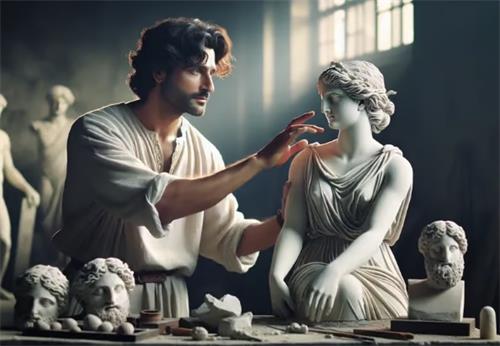
Despite his artistic brilliance, Pygmalion held an unusual view on love—he was deeply prejudiced against women, believing that real women were inherently flawed and lacked true perfection. Because of this, he vowed never to marry or have children, dedicating himself entirely to his art, convinced that only in sculpture could he find true beauty and devotion.
However, despite his rejection of real women, their image lingered in his mind. Determined to prove that art surpassed nature, he set out to carve the perfect woman—a figure more exquisite than any living being.
Under Pygmalion’s masterful hands, the statue gradually took form, becoming breathtakingly perfect. Every chisel stroke, every delicate refinement, brought it closer to life. Her face glowed like a luminous pearl under the moonlight, her skin appeared as smooth as the finest ivory, and every detail exuded an unmatched elegance. Even the most discerning eyes could find no flaw.
Yet, as the sculpture neared completion, an unexpected emotion took hold of him. He realized, to his astonishment, that he had fallen deeply in love with his own creation. Day after day, he spoke to her, imagining her loving him in return. He dressed her in beautiful garments, adorned her with jewelry, and treated her as if she were a living woman.
As time passed, Pygmalion’s sorrow and loneliness deepened. In his despair, he abandoned all hope, resigned to the cruel reality that his devotion would forever remain unfulfilled.
One day, he made his way to the temple of Venus, the goddess of love, where worshippers gathered to offer prayers and seek blessings. He simply wished for a woman who resembled his beloved statue, someone he could truly love. Venus, moved by the sculptor’s heartfelt plea and the depth of his love, decided to grant him an extraordinary gift.
As he gently touched her, he felt warmth beneath his fingertips. The once cold, unyielding marble had softened—her skin was now warm and supple, like that of a living woman. His heart pounded with disbelief and joy. Overwhelmed with happiness, Pygmalion pressed his lips to hers, and to his amazement, she responded with a tender kiss.
Words could not express Pygmalion’s elation. His beloved had been brought to life, transformed from sculpture into a real woman. In celebration of this miraculous love, he named her Galatea and soon married her in a grand ceremony. In time, they had a son, Paphos, whose name was given to one of Venus’s most cherished cities.
What began as an artist’s devotion to a lifeless creation had transcended the boundaries of reality and imagination, becoming a timeless legend of love.

Bai Suzhen,Xu Xian
A Thousand-Year Love on West Lake: The Legendary Romance of Bai Suzhen and Xu Xian
By the shores of West Lake during the Qingming Festival, the willows sway, flowers bloom, and a gentle breeze caresses the water.

Jean-Paul Sartre,Simone de Beauvoir
Jean-Paul Sartre and Simone de Beauvoir’s 50-Year Legend: A Classic Platonic Love
In 1929, the young Jean-Paul Sartre was studying at the École Normale Supérieure in Paris, filled with curiosity and passion.

Edward VIII,Wallis
Edward VIII’s Choice: Surrendering the Crown for Wallis’s Warmth
In the 1930s, the turbulence within European royalty captivated the world’s attention. Among these royal dramas, one love story stood out, becoming a legend in history—the romance between King Edward VIII of Britain and Wallis Simpson.


